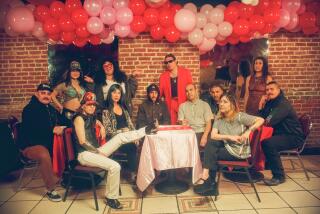Tanzania’s Tinga Tinga style, the African version of velvet Elvises, leaves an indelible print on visitors
Reporting from Mto wa Mbu, Tanzania — It was time to paint the second giraffe.
“What color do you want him?” Mwatatu Swathe, our tour guide for the day, asked. “Blue? Green? It’s Tinga Tinga. It can be anything.”
But Thomas Bosco, my art instructor, had other ideas. He squirted red, orange, brown and yellow paint from used water bottles onto the splattered table and ran a brush through all of them, swirling up cordovan.
This — the color of the penny loafers I wore in junior high school — would be the coat of my second giraffe. The dots remained black because some things must be recognizable even in the whimsical Tinga Tinga universe.
Bosco’s atelier was a thatched shed at the Ujamaa artists cooperative in the bustling town of Mto wa Mbu — also known as Mosquito River — just outside Tanzania’s famous Ngorongoro crater.
MORE AFRICA: In Zambia, a safari means going with the flow »
My husband, John Muncie, and I were here to paint Tinga Tingas, the Tanzanian outsider art we saw at roadside shops lining the routes to the country’s national parks.
It is the African version of velvet Elvises and big-eyed waifs.
Tinga Tinga art is a child of the ’60s, when Edward Saidi Tingatinga, an unemployed construction worker in Dar es Salaam, the largest city, turned old Masonite ceiling tiles, used paintbrushes and the colorful dregs in discarded bicycle paint cans into a new style of folk art. (His name is one word; the style is usually spelled as two.)
Depending on which version of Tinga Tinga history you believe, Edward Tingatinga was inspired by Congolese or Mozambican art, the mural paintings of the Ndonde people or the sayings and legends of the Makua tribal culture.
What is certain is that people responded when Tingatinga started painting colorful, whimsical, semi-cartoon animals with lots of dots.
Fifty years later, the eponymous Tinga Tinga style can be found in art galleries and street corners all over Tanzania and painted on stretched canvases, keychains, purses, salad servers and more.
Our first contact with Tinga Tinga art occurred in late February soon after we landed in Arusha, the main city near the base of Mt. Kilimanjaro and Tanzania’s safari central. Our hotel gift shop had an assortment of dotted, whimsical Tinga Tinga animals.
From there — guided by Infinite Safari Adventures, a Los Angeles-based African tour company — we made the classic trek to Tarangire National Park, Ngorongoro Conservation Area and Serengeti National Park.
Tinga Tinga accompanied us the whole way. The closer to a game park, the more dense the shops. We stopped counting at Mto wa Mbu after passing more than 20.
At the entrance to Serengeti National Park you could buy a pack of Tinga Tinga postcards or a Tinga Tinga-decorated headband.
The roadside Tinga Tinga paintings I saw sold for $35 to hundreds of dollars, depending on the size of the canvas and the complexity of subject.
But price and provenance are tricky things in the Tinga Tinga world.
MORE AFRICA: It’s Namibia’s purity that compel people to visit »
Every roadside painting is subject to bargaining, and the expensive Edward Tingatinga-signed paintings we admired in Arusha’s Cultural Heritage Centre (priced at $2,800 each) and in galleries in Zanzibar’s Stone Town ($500 for two, if you bargain) may not be as original as advertised. Ask for a certificate of provenance if you want to make sure.
The hunt for original Tinga Tingas (by Edward) has become fierce with the style’s growing popularity.
“Collectors go house to house in Dar es Salaam looking for originals,” a Stone Town dealer told us.
But authenticity seems beside the point. Tinga Tingas are like roadside flowers: vibrant and fun (think Pogo-meets-National Geographic-meets Kandinsky) and as colorful as the clothes of Tanzanian women.
Mr. Macho, a Tinga Tinga artist and owner of the Secret Shop in Mto wa Mbu, summed up the modern attitude toward Edward Tingatinga. “I’m much better,” Macho said with a wide smile. “He’s past, I’m here.”
Macho (whose real name is Kisuph Macho Banda) is from Dar es Salaam, where he learned the Tinga Tinga style at the Tingatinga Arts Cooperative Society.
Hasin White, a Tinga Tinga artist in a roadside shop outside Tarangire National Park, had a similar story.
“I learned in Dar from people from the Tinga Tinga studio,” he said.
As I looked over his shoulder at a painting in progress of a Noah’s ark of Tinga Tinga animals, I asked him what was key to the Tinga Tinga style.
“You present the animals like a cartoon,” he said. But he explained that his half-finished work wasn’t a “real” Tinga Tinga.
He pointed to a vibrantly green painting of a mama hyena and her cub and said, “That one is real Tinga Tinga. Mr. Tingatinga only painted one animal and maybe a cub.”
The Tinga Tinga I learned to paint has two adult giraffes. Edward Tingatinga might not approve, but it’s hanging in my bedroom gallery nevertheless.
@latimestravel
More to Read
Sign up for The Wild
We’ll help you find the best places to hike, bike and run, as well as the perfect silent spots for meditation and yoga.
You may occasionally receive promotional content from the Los Angeles Times.






